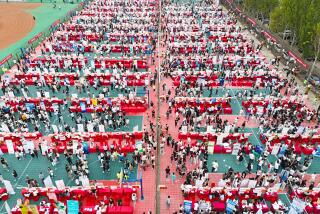China worries about losing its character(s)
- Share via
Reporting from Beijing — Texting and typing are replacing the elaborate strokes that make up written Chinese. And when it comes time to jot down a few words, more Chinese are realizing they can’t remember exactly how.
For Ma Silang, the long descent into forgetfulness began after he graduated from high school, went off to London for three years to study photography and bought his first computer.
Now the 30-year-old fashion photographer, a native Beijinger, has such difficulty writing in his mother tongue that the other day when he was scribbling a shopping list for himself he suddenly realized that he had forgotten one of two characters that make up the Chinese word for “shampoo.”
“It is inevitable that we forget our Chinese characters unless we make a special effort to practice writing a few hours each week, and who has time for that?” said Ma, looking up from an iPhone on which he was tapping a message while waiting for his MacBook to be repaired at Beijing’s Apple store.
This is a strange new form of illiteracy — or, more exactly, dysgraphia, the inability to write — that is peculiar to China. The epicenter of the contagion is in places like the Apple store, a multilevel, glass-facaded emporium for China’s tech-savvy.
The typical victim is someone like Ma — dressed in a pinstriped, button-down shirt, Bermuda shorts and loafers, he looks as if he stepped out of a Ralph Lauren ad — who is young, well-educated and affluent.
The more gadgets people own — cellphones, smart phones, computers — the less often they go through the elaborate sequence of strokes that make up Chinese characters. Whether on their computers or texting on phones, most Chinese use a system where they type out the sound of the word in Pinyin, the most commonly used Romanization system — and presto, they are given a choice of characters to use.
No muss, no fuss, no pens, no pencils — not to speak of inkwells and calligraphy brushes.
“People don’t write anything by hand anymore except for name and address,” admitted Ma.
Almost any Chinese person you meet will confess to a lapse of memory, almost like a senior moment. The hand clutching the pen or pencil is poised above a sheet of paper about to write a character learned in childhood and memorized in countless repetitions when — suddenly — an embarrassing pause.
In an April poll commissioned by the China Youth Daily, 83% of the 2,072 respondents acknowledged problems with writing characters. The phenomenon is so common that there is even a name for it, tibiwangzi, which translates to “take pen, forget character.”
“The other day I was writing a note by hand and when I came to the word zaijian [goodbye], I did sort of a double-take because I wasn’t sure I’d written the zai correctly,” said 18-year-old Cheng Jing, a college freshman.
To some extent, similar problems arise anywhere that people rely on technology rather than memory — outsourcing of the brain, as they call it in the many treatises that address the question of whether computers and the Internet are stifling our intelligence.
In China, the situation rises to the level of a cultural crisis since the characters, more than any other facet of life, epitomize thousands of years of tradition.
Chinese is the oldest continuously used writing system in the world; the characters used today can be traced to pictographs found on bones and turtle shells dating to 1200 BC.
Even though in the 1950s Mao Tse-tung ordered the simplification of many characters to promote wider literacy, much of childhood in China is still spent memorizing and copying. By the time students are 15, they will have spent about four to five hours per day over nine years learning to write a minimum of 3,000 characters.
Writing, moreover, is not merely about communication — in Chinese culture, it is an art form and spiritual exercise, believed by some to improve concentration, longevity and even martial arts skills.
“These characters are in the soul of every Chinese person,” said Wang Jianxue, a 38-year-old calligraphy teacher from Harbin who was lovingly leafing through the stacks at a bookstore in Liulichang, a street of quiet shops that sell brushes, ink stones, rubbings, scrolls and curios. “The nation has to maintain its personality through its characters. They are our cultural heritage. The computer is just a tool.”
Outside the shop, a man in white silk pajamas traced characters in water on the pavement with a device that looked more like a sponge mop than a brush. “This is my hobby,” 41-year-old Wang Jiazhong said as he wrote out the characters meaning “beautiful spring day” and then watched them disappear as the water evaporated in the beating sun.
“Chinese people these days care only about material life. Even in Japan and Korea more people practice calligraphy than here. How could such a thing happen when the characters began here?” he complained. “The government has to do something. Without government intervention, people won’t pay attention.”
In fact, the Chinese government is beginning to take notice. In 2008, the Education Ministry surveyed 3,000 teachers around the country and found 60% complaining about declining writing ability. As a result, the ministry last year launched a writing competition with 10 million participants and has begun pilot programs to make students do more handwriting.
“It is not about producing beautiful calligraphy,” said Yu Hong, who runs the ministry’s program on writing language. “We want to help students to come back to writing again.”
The decline of handwriting probably has less to do with the computer than the cellphone. The Chinese do more text messaging than anybody else in the world, perhaps because it is an inexpensive way to communicate and because the Chinese language can squeeze a lot of information into a small space. (One example is a single character, pronounced “zha,” which means the red dots that appear on your nose when you are drunk.)
With cellphones that have a stylus and touch screen, you can draw the character you want to text, and many older Chinese prefer that method. But younger Chinese, who are more comfortable with the alphabet, will write out the Romanized version of the word — or an abbreviation, such as “bei” for Beijing.
Last year, educators held the first nationwide conference on the issue. Among the remedial measures discussed is requiring college students to write out papers by hand, which would have the added benefit of making it harder for them to plagiarize by cutting and pasting text from the Internet.
“I tell my students I find reading their handwriting to be a pleasure, but most of my colleagues frankly don’t want to bother,” said Lu Lingxiao, a professor at Guangxi University, who was a participant at the conference in the southern city of Nanning. “If my colleagues and the government don’t start taking it seriously, I worry that our level of literacy will suffer.”
Many young Chinese are sufficiently concerned that they have taken it upon themselves to study calligraphy.
“It will take a lot of effort to preserve our Chinese characters. It is the same way they try to preserve these old hutongs,” said Zhu Linfei, 24, a Beijing graduate student, referring to the traditional Beijing alleys, now rapidly succumbing to the wrecking ball.
Zhu, who was touring the old bookstores of Liulichang with her classmates to buy calligraphy books, estimated that she had already forgotten about 20% of the characters she knew in high school.
“But it’s not such a big problem,” she said. “If I don’t know a character, I take out my cellphone to check.”
Nicole Liu and Tommy Yang of The Times’ Beijing Bureau contributed to this report.
More to Read
Sign up for Essential California
The most important California stories and recommendations in your inbox every morning.
You may occasionally receive promotional content from the Los Angeles Times.










